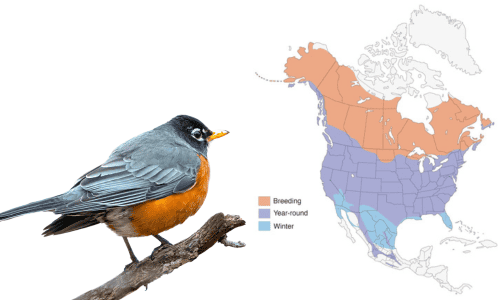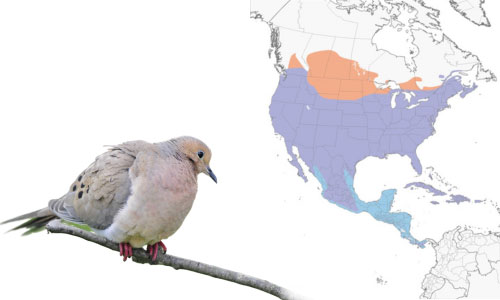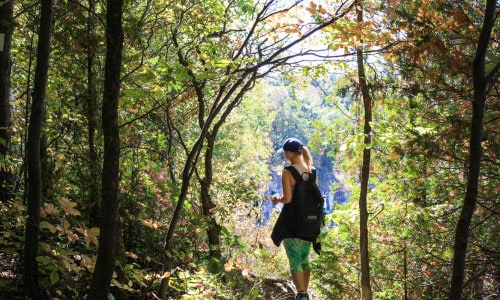Iowa is home to many corn and bean farms and a wide variety of habitats that are suitable for birds to thrive in. There are over 300 different avian species in the state, and wherever you are in Iowa, you can find some common feathered friends in your garden.
How many common birds in Iowa can you name? Do you recognize every bird that comes to your backyard and eats off your feeders in Eastern Iowa? Are you interested in learning about them?
If yes, you are in the right place! We have information about your local avians, from backyard birds to rare Iowa birds.
Table of Contents
Native Bird Species of Iowa
There are hundreds of types of birds in Iowa, over 390 species, to be exact. This ranges from the north, south-central, to midwestern part of Iowa.
The majority of these birds in Iowa visit backyards and are a common sight for many homeowners. Let’s take a look at our Iowa birds list to get to know these avian species more.
1. Northern Cardinal

- Scientific Name: Cardinalis cardinalis
- Weight Range: 42 to 48 grams
- Approximate Length: 21 to 23 centimeters
- Wingspan: 25 to 31 centimeters
The Northern Cardinal is well known for its mohawk-like crown and short red-orange bill, The males’ red plumage and black mask are visible even from a distance. The females are orange-brown overall with patches of red on their crest, wings, and tail.
These red birds can be spotted around the shrubby woodland edges of Iowa throughout the year. They also frequent bird feeders for black oil sunflower seeds and nuts, effortlessly cracking the seeds and splitting the hulls with their thick, conical bills.
During its breeding season, the Northern Cardinal can be very aggressive. They will defend their territories and sometimes even attack their reflection on glass surfaces.
In winter, Northern Cardinals will keep their plumage color, since they don’t molt. You can spot them in Iowa even in the cold season as they don’t migrate.
2. White-breasted Nuthatch

- Scientific Name: Sitta carolinensis
- Weight Range: 18 to 30 grams
- Approximate Length: 13 to 14 centimeters
- Wingspan: 20 to 27 centimeters
The White-breasted Nuthatch is the largest of all nuthatch species, but still smaller compared to most birds. They have short tails, narrow upturned bills, blue-gray bodies, chestnut-colored lower bellies, and white cheeks. Males have black crowns while females have gray ones.
White-breasted Nuthatch is one of the three nuthatches found in Iowa. These small birds prefer deciduous and mixed forests, suburbs, and parks where they feed on insects and spiders. They are well adapted to humans and are frequent visitors of bird feeders, always after suet and sunflower seeds.
Nuthatches are monogamous. The pair will remain together in their territory all year, as they are mostly permanent residents.
3. Black-capped Chickadee

- Scientific Name: Poecile atricapillus
- Weight Range: 9 to 14 grams
- Approximate Length: 12 to 15 centimeters
- Wingspan: 16 to 21 centimeters
Often referred to as cute for their oversized head and small bodies, Black-capped Chickadees are undoubtedly one of the most well-loved backyard birds in Iowa. Both the male and female share the same black cap and bib. But if you look closely, males have a slightly larger bib than females.
In terms of plumage differences in the summer versus winter, not much can be observed except for the wing feathers. Its white edges seem clearer during the cold months.
These black and white birds are residents of Iowa all year long. You can find them in thickets, open deciduous forests, backyards, and parks. They frequent bird feeders and are always the first ones you’ll see after installing one.
Black-capped Chickadees’ diet includes seeds, insects, and berries. Breeding season starts in mid-April through early June for these birds. They don’t migrate.
4. American Robin

- Scientific Name: Turdus migratorius
- Weight Range: 77 to 85 grams
- Approximate Length: 20 to 28 centimeters
- Wingspan: 31 to 40 centimeters
This bird is a part of the Thrush family and is used as a key species to identify unfamiliar birds. American Robins are known to have rust-colored breast feathers, white lower belies, and darker brown backs. They also have a round body and long tail, which they often flick when landing.
American Robins are birds native to Iowa. They are common residents in the northern half of the United States, inhabiting farmlands and open woodlands.
You can find them hopping in backyards, foraging for invertebrates and fruits to eat. It is rare to find them in bird feeders, since their diet does not consist of seeds.
In winter, these birds move to the southern half of the United States such as Central America and Mexico. They breed in Alaska and Canada after returning to their homes in the north during the summer months.
5. Mourning Dove

- Scientific Name: Zenaida macroura
- Weight Range: 128 grams
- Approximate Length: 31 centimeters
- Wingspan: 37 to 45 centimeters
Mourning Doves are gray-brown birds with broad elliptical wings and rounded heads. Both sexes share the same long and thin tails, black wing spots, blue rings around the eyes, and salmon-colored legs. Plumage color is relatively static throughout different seasons.
These birds are present year-long throughout Iowa, perching on telephone wires or high trees. They prefer to stay in semi-open areas, from farmlands, grasslands, and woods to urban areas. While they are frequent tray feeder visitors, you can also spot them on the ground foraging for fallen seeds.
It is commonplace for Mourning Doves to find a new mate each breeding season rather than stay with their previous partners. This phenomenon is called seasonal monogamy, where the birds bond strongly and stay faithful to their mate for only a season.
After breeding in the north, Mourning Doves migrate to southern Canada through the northern Midwest. Some of them have shorter migrations than others.
6. Indigo Bunting

- Scientific Name: Passerina cyanea
- Weight Range: 12 to 18 grams
- Approximate Length: 12 to 13 centimeters
- Wingspan: 19 to 22 centimeters
These small and stocky song birds are renowned for the vivid blue plumage and black wing and tail streaks of the males. Females are pale gray-brown with diffused stripes. Indigo Buntings are often confused with Blue Grosbeaks, but the size difference between the two is a discerning feature.
Aside from breeding in Iowa during the summer, you can also find these birds in southern Canada stretching to Maine, eastern Texas, Florida, and west of southern Nevada. They inhabit weedy and brushy areas where fields and forests meet.
Indigo Buntings forage shrubs and bushes for seeds and insects. You’ll see them more in hopper feeders on their first arrival in late spring after migrating.
Indigo Buntings are solitary while breeding but form large flocks when migrating.
7. Downy Woodpecker

- Scientific Name: Dryobates pubescens
- Weight Range: 21 to 28 grams
- Approximate Length: 14 to 17 centimeters
- Wingspan: 25 to 30 centimeters
Downy Woodpecker is the smallest woodpecker species in the United States. Their unique features include black wings and upper parts, white throat, back, belly, and white wing spots. Both sexes have almost similar color patterns, except males have a red spot at the back of their heads.
These small woodpeckers are present in Iowa no matter the season. You can find them in deciduous forests in northernmost Alaska and Canada. If you see Downy Woodpeckers on tree trunks, they are more likely females, since males are often spotted in smaller plants.
Attracting these birds to your backyard feeder will work if you use suet and sometimes black oil sunflower seeds and peanuts. Their diet also includes insects and fruits.
Downy Woodpeckers find nest cavities to lay their eggs and raise their young. They pick tree bark in the summer and dig the ground in winter. During the cold months, you will spot them in suburban backyards, relying on bird feeders, since they don’t migrate.
8. American Goldfinch

- Scientific Name: Spinus tristis
- Weight Range: 11 to 20 grams
- Approximate Length: 11 to 14 centimeters
- Wingspan: 19 to 22 centimeters
In the spring lasting through early summer, Male American Goldfinches have yellow plumage, black temples, and tails with white spots. Females are more brown than yellow with olive upperparts. In winter, their feathers look duller.
American Goldfinches inhabit the forests and plains of North America where weeds are abundant. They are also present in many parks and backyards, visiting feeders, especially during the cold months.
The mating season for these birds starts later in the year compared to any other finches. Male American Goldfinches will display their brighter and more beautiful than ever plumage to attract a partner.
As a short-distance migrating finch, American Goldfinches can only travel a limited distance. They move to Southern Canada, extending to the south in some parts of Mexico.
9. House Sparrow

- Scientific Name: Passer domesticus
- Weight Range: 24 to 40 grams
- Approximate Length: 14 to 18 centimeters
- Wingspan: 19 to 25 centimeters
House Sparrows are mostly brown, with the males having dark brown feathers, a gray crown, black neck and face, and the rest of their bodies a dull grayish brown shade. Females, on the other hand, are brown with no black coloring.
These birds are in many places around the world; thus, earning the title of the most widely distributed wild bird on Earth. One reason for this is their strong association with human habitats, allowing them to thrive in urban and rural areas.
House Sparrows can breed shortly after hatching. It is not unusual to have their first mating season at only a few months old. However, the reproductive success of these juvenile breedings is still lower compared to adults.
In some areas, you might find migrating House Sparrows. But in general, these birds stay in the region where they live and rarely move away during winter.
Popular Bird Watching Locations in Iowa
Knowing where to look is the key to getting a stunning view and photos of Iowa birds. Here are the 2 places perfect for birders!
1. Yellow River State Forest
Located in northeast Iowa, this approximately 8,900 acres of hiking trails and amenities is the perfect place to bird watch.
The designated Important Bird Area is protected and is home to winding trout streams, stunning cliffs, hardwood forests, and impressive views. Its location and diverse habitat make it the ideal place for observing wildlife.
2. Makoke Trail
The highlight of birding in Central Iowa is the Makoke Trail. It was opened in May 2009 and is conveniently within driving distance of Des Moines.
Makoke Trail offers such an excellent bird-watching experience that a guidebook about it was published, detailing the visitor centers in the area, perfect viewing spots, best time to visit, birding access, and aerial shots.
Some of the bird species you can find in this birding trail are Ovenbird, Red-headed Woodpecker, Yellow-throated Vireo, Eastern Bluebird, Broad-winged Hawk, Wood Thrush, Scarlet Tanagers, Summer Tanagers, and a lot more!
There are many popular birds in Iowa all year round. But if you want to get the best experience, then you shouldn’t miss the Spring and Fall migration. Early mornings and late afternoons will present birders with opportunities to spot and hear birds of Iowa sounds.
During winter, tons of birds will head south to escape the cold, but you can still have a memorable bird watching experience. Look for species that overwinter and see how their plumage differs!
Conclusion
After reading this article, do you know more common birds in Iowa than before? Did you have fun going through the birds photos we’ve included and the bird identification information?
We hope you do! Let your bird-loving family and friends know about this article. You can also share your unique and memorable bird encounter with us in the comment section!
Most Common Birds in:

George and I became friends after a birdwatching trip with our new group. And we have been enjoying every adventure together. When he told me the idea of establishing a site that shares our experiences and fun, I immediately agreed. After trials and errors, here we have Thayerbirding.
















